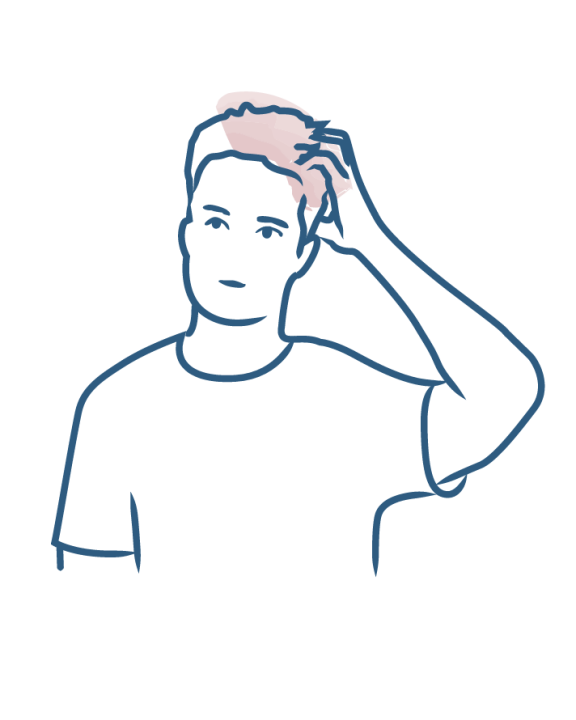Causes of itching: why do we scratch?
Dermatological Pruritus

Dermatological Pruritus
Pruritus is the unpleasant sensation which causes the sufferer to scratch. Many people are affected by pruritus on a daily basis, children as well as adults and elderly people, both men and women. Pruritus and itching accompany many skin diseases, in these cases we call it dermatological pruritus or pruritus of dermatological origin. A brief overview of the main skin diseases that can cause itching, and the solutions available to relieve them.
Recognizing dermatological pruritus
Dermatological pruritus is pruritus that originates from one or more skin lesions, i.e., from a skin disease or condition.
Thus, dermatological pruritus is relatively easy to recognize, since it involves abnormalities present on the skin, such as spots, plaques, scars, etc. Most of the time, dermatological pruritus is initially localized to these abnormalities but it can also become chronic (persistent for more than 6 weeks) and more diffuse. Scratching can lead to additional lesions called scratch lesions.
What skin diseases can cause itching?
Many skin diseases can be the cause of itching. The main skin diseases that cause pruritus are frequent inflammatory dermatoses:
Eczema
Eczema is characterized by the presence of red plaques, dry skin and itching. There are several types of eczema, the most common of which are atopic eczema, contact eczema and chronic hand eczema.
Psoriasis
Psoriasis is characterized by the presence of more or less extensive red plaques, generally pruritic and covered with a thick layer of white scales.
Seborrheic Dermatitis
Seborrheic dermatitis affects the skin and/or scalp. It is defined by the presence of poorly defined red plaques covered with small, more or less greasy, non-adherent scales. Here again, pruritus is often very present and poses a daily problem.
Hives
Hives, or urticaria, is the appearance of mobile, red, raised and itchy patches. Hives is considered acute when it lasts less than 6 weeks, and chronic beyond that. There are many causes of hives, both allergic and non-allergic.
Other less common skin diseases are also associated with pruritus:
- Ichthyosis: a rare genetic disease in which the skin is very dry, rough and scaly.
- Bullous pemphigoid: an bullous autoimmune disease that affects the elderly.
Many infectious dermatoses cause pruritus:
- Scabies: a highly contagious parasite caused by a mite, the itch mite, which digs microscopic grooves into the skin. Pruritus is often intense and becomes worse at night.
- Lice: head lice are the most well-known kind, but there are also body lice and pubic lice.
- Chickenpox: probably the most well-known childhood disease. It is viral in origin and extremely contagious.
Skin allergies are another relatively significant category of dermatological pruritus. One can be allergic to metals such as nickel (particularly present in costume jewelry), perfumes, dyes, preservatives, etc.
Finally, dematological pruritus can result from more isolated skin afflictions such as insect stings or bites, reactions to certain plants, or sunburn.
In cases of pruritic dermatosis, the challenge is not scratching the lesions in order to avoid superinfections of the skin and/or healing wounds.
Relieving itching related to dermatological pruritus
Dermatological pruritus can be treated in many ways. In fact, it all depends on the skin condition involved. For example:
- Eczema is usually relieved by the use of topical corticosteroids and emollients.
- Severe forms of psoriasis are treated with injectable medications called biotherapies.
- Scabies requires the application of anti-parasitic creams and/or oral ivermectin.
Thus, to relieve dermatological pruritus, it is often necessary to consult a doctor and to comply with their prescription. At the same time, you can implement a few simple hygiene and treatment rules to help you take care of your skin on a daily basis and prevent damage. For example, opt for warm, quick showers. Use a superfatted soap, a syndet or a cleansing oil, without perfumes and without irritating substances. Rinse well, and dry the skin by gently dabbing with a soft towel. Keep fingernails short, and wear comfortable cotton clothes.
If you feel like scratching, apply something cold to the area: thermal spring water, the back of a spoon, a fan, a bag of frozen peas, etc.
More information
- Discover Pruritus gravidarum or itching related to pregnancy
Causes of itching: why do we scratch?
Pruritus gravidarum or itching related to pregnancy
- Discover Aquagenic Pruritus
Causes of itching: why do we scratch?
Aquagenic Pruritus
- Discover Senile Pruritus
Causes of itching: why do we scratch?
Senile Pruritus
- Discover Sun Allergy
Causes of itching: why do we scratch?
Sun Allergy
- Discover Pruritus sine materia
Causes of itching: why do we scratch?
Pruritus sine materia
Our care routines
Itching on the scalp
Dermatological expertise
To better understand your skin and hair, discover our exclusive content and innovative care products designed to improve your quality of life..

